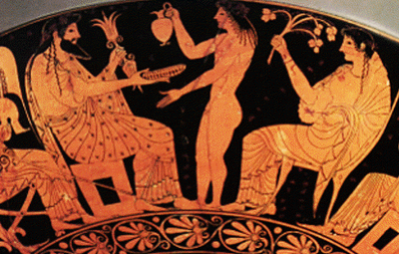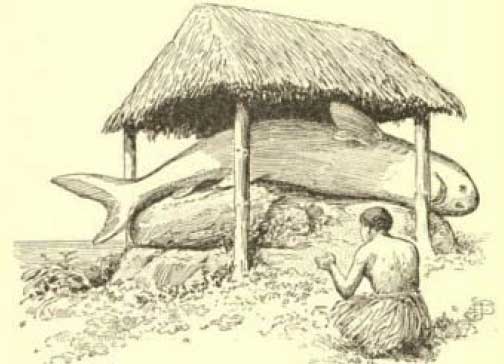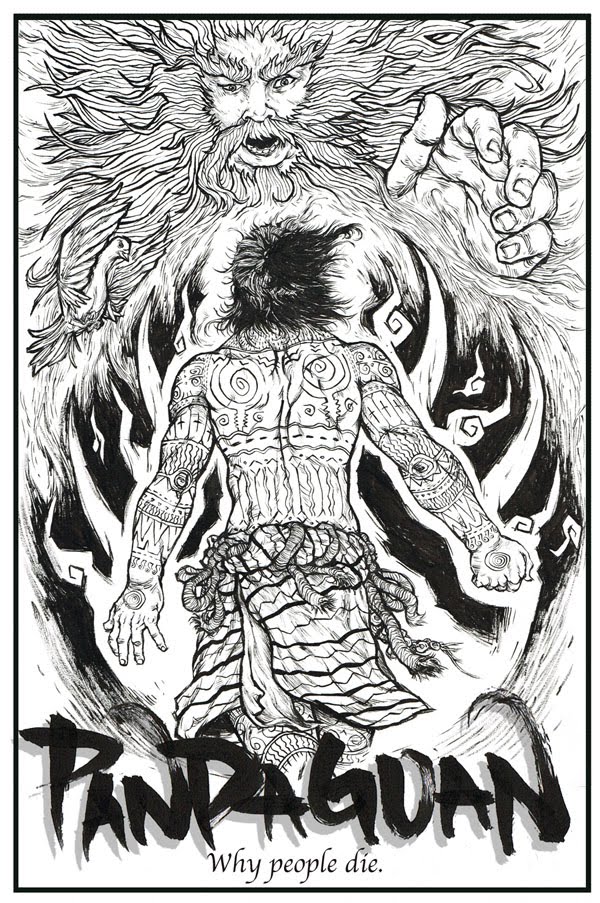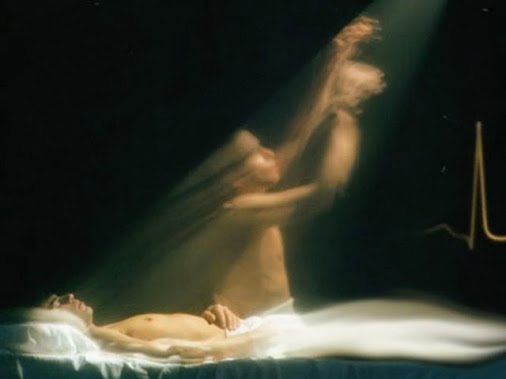There is no shortage of tales about immortality. Call it a age long human obsession or a divine mission that carries our minds from magic to science. Nevertheless mythology and folklore will always features beings who are untouched by death and characters who engage in perilous quests to find artifacts that will give them the much coveted gift of everlasting life.
From the Holy Grail of Arthurian legend, the Ambrosia of the Greek gods, and even eating the meat of a legendary mermaid in Japanese folklore, these stories reflects human ambition to challenging their own mortality and pursue something that deviates the law of nature itself. If we look into Philippine lore, it was quite the opposite: immortality was a gift they enjoyed from the start. Only after losing it did they find magical ways of apparently getting it back.

Like any gift, the receiver will always have the right to keep it or throw it away. Pandaguan, the protagonist in a Bisayan story of creation, without any second thought chose to leave the gift behind. His reasoning was that both mortals and immortals will always be afflicted with anger and sorrow no matter how short or long their existence.
Immortality and Heartbreak
The Boxer Codex narrates the story of Pandaguan, one of the known ancestors of the Bisayans and inventor of the art of fishing. During one of his fishing trips, he accidentally caught and killed a shark in his traps. As he brought the shark on the shore, Pandaguan gave funeral rites as if the animal he slayed was human. This act angered the god and prompted them to enact the first known death of a human. Magwayen, a diwata like being that functions as a psychopomp, was tasked to send a lightning bolt that killed the fisherman.

Pandaguan found himself in the heavens together with the gods who conferred with him. After thirty days, he was send back to the world to live once more without knowing that during the time he was gone, his wife Lobloban moved on and was now living with another man, Marancon, who became known as the inventor of thievery.
Pandaguan asked his son, Anoranor, to tell his mother that he is alive and he will wait for her in their house. However, the moment Anoranor relayed the new, Lobloban become angry and insisted that her son was lying. She even reasoned out that the shark killed by Pandaguan didn’t return to life so how come her husband would be resuscitated.
Grief stricken after hearing his son’s narration on what Lobloban’s response was, he decided to leave this world and never come back. He is said to now reside in Sular, a place which projects the same concept of hell to the Bisayans.
In another version of the story, Pandaguan bears an arrogant personality as he claims that he can slay the gods since he managed to kill the shark – which he boasted bears the same size as a god. Kaptan, chief god of the Bisayans, teach him a lesson by striking him with a thunder bolt but it was not meant to kill him. After thirty days lying on the ground, he was revived, yet his skin turned to black and thus all his descendants were also dark skinned.
Versions of this story always seem to end in a somewhat tragic conclusion, but the ancient Bisayans derived their beliefs in the tale that men are originally immortal. Because of Pandaguan’s actions, humans became mortal and will all journey to Sular when they die.

A Rightful Place for the Dead
Sular was essentially perceived as hell, and was not entirely a good place for souls to rest. A Babaylan would need to intervene and hold a sacrificial ritual for the gods in order to place the soul of all the dead in a certain area in the island. There, they cannot be seen by any person and the rest of their lives would be spent in a luxurious feast. They called the ritual Maganito, which was done by Baylanes or Baysanas. Using a spear, they would slaughter a pig. Only the Baylanes would have the right to touch the head of the pig as it was possibly thought to be a sacred as the god they were making the offering to.
After the ritual, the Baylan would eat the head of the pig and the rest of the meat would be divided among the people. They would continue to celebrate and feast with rice wine until they were full and drunk. Many rituals stated in the Boxer Codex often depict early Filipinos including feasts and merriment in their ceremonies, which could be the reason why Filipinos love to celebrate today – for it was once a sacred ritual where everyone would take part.
How To Attain Immortality Now?
The tale of Pandaguan depicts how man lost a boon that once held him on par with gods. However, there are still other Philippine folktales that give us a clue (although in a fictional sense) of how a person can achieve immortality once again. One example is the popular story of the Tama-wo or Lomon, mystifying and beautiful beings that reside in a place that can only be reached through the Balete tree. When one of these beings would fall in love with a mortal, they would gift them magical rice that would move through their body, granting them immortality.
Another being that can provide a way to immortality is the Litao. These are male deities of the water in Ilokano folklore who offer an elixir mixed with their own blood. When consumed by a human, they would gain immortality…with one catch – they would become a half human/ half fish being.
The story from the Tiruray of Mindanao about the hero Lagey Lingkuwos and his six followers is another tale of immortality. The protagonists would eventually live in the sky and become the origin of the six constellations used by Tiruray in agricultural and hunting seasons.
Lastly (though I believe the least appealing option among the four) is to turn yourself into an Amaranhig. Like the standard zombies that we all know, an Amaranhig is being that escaped the grave at the price of having a hunger for human flesh. They originated from Aswang who died just before they fully transferred themselves to another, or refused to transfer themselves. Although they have a very stiff legs that makes them poor climbers, Amaranhig are able to tirelessly pursue, which proves to be deadly despite their limited mobility.
I found an interesting story related to the Amaranhig tale where it was said that a Datu wanted to create an invincible army of warriors that never died in battle. With the help of the Babaylan, they conducted a ritual on the dead bodies of his men by coating their corpses with dark ashes and putting strange stones in their mouths. Through this he created a powerful army that only dies when they accomplished the tasked given to them. I tried to find any source from this story as to where it came from but as on now I can’t seem to find whether the “undead” army of Datu was part of any traditional lore in the Philippines.

Immortal By Body or By Soul?
Immortality itself is a broad word that signifies more than just the permanency of the biological body as depicted in many novels we’ve read and stories we’ve seen on television or in the cinema. Mystical beliefs, as well as some mythological tales , give emphasis on the immortality of the soul instead of the body. It is widely accepted by many cultures and religion that man possess a lasting “body” and, like energy itself (as stated in the Law of the Conservation of Energy) cannot be created or destroyed.
Pre-colonial Filipinos, with their animistic base spirituality, believed heavily in the transmigration of the soul in the afterlife. To Tagalogs, the place where the soul goes to is either Kasanaan or Maca. Bagobo on the other hand believe that man possess two souls; one will go to heaven and the other one to the underworld or will stay on earth to haunt the living. Among Ilokanos, every person has three souls known as Kararwa, Alingaas and Karma and each of these have a different destination to go after death.
In society, there are people who gain an “immortalized” status after their death by igniting a change or revolution, not just in their nation but throughout the world. Their works, advocacy and discoveries leave their name in the hallmarks of everyone’s mind for countless generations.
Among the things that can be immortalized, there is only one that I hope for. Despite the infinite number of things that come and go in our lives, I wish one will remain enduring against death: the values that makes us realize that whether our life is short or permanent, what matters most is we try our best to live not just for ourselves but for everyone around us. And by doing this simple act, we don’t need the blood of a Litao, nor the rice of Tama-wo. Our good deeds, cultural contributions, and shared knowledge will immortalize us just as firmly as the constellations in the Tiruray sky.
ALSO READ: Ancient Visayan Story of Creation | Philippine Mythology
ALSO READ: Stars Through the Eyes of Ancient Filipinos
Currently collecting books (fiction and non-fiction) involving Philippine mythology and folklore. His favorite lower mythological creature is the Bakunawa because he too is curious what the moon or sun taste like.


